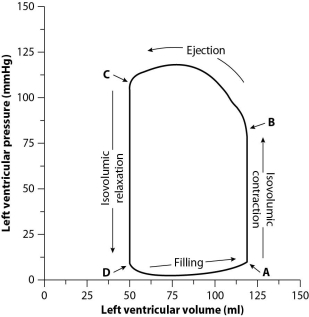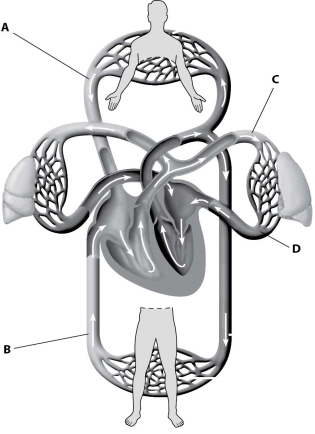A) artery
B) capillary
C) venule
D) vein
Correct Answer

verified
Correct Answer
verified
Multiple Choice
Plasma proteins are involved in all of the following activities except
A) fighting infection.
B) maintaining osmotic balance.
C) carrying oxygen.
D) blood clotting.
Correct Answer

verified
Correct Answer
verified
Multiple Choice
The liquid part of blood is called
A) water.
B) plasma.
C) serum.
D) interstitial fluid.
Correct Answer

verified
Correct Answer
verified
Multiple Choice
One way that substances move between blood and interstitial fluid is by
A) alternatively breaking and regenerating membranes of cells lining capillaries.
B) osmosis.
C) pressure-driven flow through clefts between the epithelial cells of the capillary wall.
D) active transport utilizing ATP.
Correct Answer

verified
Correct Answer
verified
Multiple Choice
You are dissecting a "mystery animal" in biology lab and discover that it has a series of closed blood vessels, a pair of lungs, two atria, and a single ventricle. What animal are you dissecting?
A) fish
B) frog
C) crocodile
D) bird
Correct Answer

verified
Correct Answer
verified
Multiple Choice
After reading the paragraphs below, answer the questions that follow.
To evaluate cardiac function, scientists and physicians measure both the pressure and the volume inside the heart. When both pressure and volume data are plotted on the same graph, the resulting graph is called a pressure-volume loop. To create a pressure-volume loop, a catheter (a thin tube) is inserted into the vessels of the heart, and measurements of both left ventricular pressure and left ventricular volume are taken. The data are plotted on a graph, and cardiac function can then be evaluated from the distribution of the data and the shape of the loop.
The figure below shows a typical left ventricle pressure-volume loop for a healthy young adult. The cardiac cycle proceeds counterclockwise. Each complete turn around the loop (for example, starting at point A and ending back at point A) represents one complete cardiac cycle.
 -If the time it takes to go around the loop is 1 second, what is the cardiac output in units of liters per minute?
-If the time it takes to go around the loop is 1 second, what is the cardiac output in units of liters per minute?
A) 3) 9 L/min
B) 4) 2 L/min
C) 7) 0 L/min
D) 8) 1 L/min
Correct Answer

verified
Correct Answer
verified
Multiple Choice
The largest blood vessel in the human body is the
A) superior vena cava.
B) pulmonary vein.
C) aorta.
D) pulmonary artery.
Correct Answer

verified
Correct Answer
verified
Multiple Choice
How long do human red blood cells circulate in the blood before they wear out and have to be replaced?
A) 1 to 2 weeks
B) 1 month
C) 3 to 4 months
D) 10 to 12 months
Correct Answer

verified
Correct Answer
verified
Multiple Choice
To view the path of blood flow through the heart and body, scientists and physicians perform an angiogram by injecting a dye into the blood and monitoring its movement. Imagine that this dye was injected into the pulmonary vein. Which of the following is the correct order of structures that the dye will flow through?
A) lungs, pulmonary artery, left atrium, left ventricle
B) left atrium, left ventricle, aorta, body arteries
C) right atrium, right ventricle, aorta, body arteries
D) lungs, pulmonary artery, right atrium, right ventricle
Correct Answer

verified
Correct Answer
verified
Multiple Choice
Whether there is a net flow of fluid into or out of a capillary at a given point along its length depends upon
A) whether the fluid contains nutrients or wastes.
B) whether or not the fluid contains oxygen.
C) the balance between blood pressure and osmotic pressure.
D) the needs of the tissue.
Correct Answer

verified
Correct Answer
verified
Multiple Choice
Which of the following statements about blood clotting is true?
A) The first response to an injury is dilation of the damaged blood vessels.
B) During the clotting response, platelets rapidly congregate in the interstitial fluid.
C) Fibrin is enzymatically converted to fibrinogen.
D) Threads of fibrin form a fibrin clot.
Correct Answer

verified
Correct Answer
verified
Multiple Choice
Which of the following cells are phagocytes?
A) monocytes and neutrophils
B) basophils and eosinophils
C) lymphocytes only
D) lymphocytes, basophils, and eosinophils
Correct Answer

verified
Correct Answer
verified
Multiple Choice
In humans, which blood vessels have valves?
A) arteries in the neck
B) arterioles
C) capillaries
D) veins
Correct Answer

verified
Correct Answer
verified
Multiple Choice
Oxygen-poor blood is carried from the heart of a mammal to the lungs via the
A) pulmonary arteries.
B) pulmonary veins.
C) superior vena cava.
D) inferior vena cava.
Correct Answer

verified
Correct Answer
verified
Multiple Choice
In which part of this figure would blood have the lowest oxygen content? 
A) part A
B) part B
C) part C
D) part D
Correct Answer

verified
Correct Answer
verified
Multiple Choice
Hematocrit is the percentage of red blood cells in the blood. In adult humans, hematocrit is roughly 40-45%, but it can be much higher or lower in other animals. Consider the Weddell seal, a mammal that can dive and hold its breath underwater for upwards of 80 minutes. What is the hematocrit level of a Weddell seal, and why?
A) It is likely lower than that of an adult human because the seal needs access to less oxygen when diving.
B) It is likely lower than that of an adult human because the seal needs access to more oxygen when diving.
C) It is likely higher than that of an adult human because the seal needs access to less oxygen when diving.
D) It is likely higher than that of an adult human because the seal needs access to more oxygen when diving.
Correct Answer

verified
Correct Answer
verified
Multiple Choice
As blood moves away from the heart toward the tissues, the relative size of blood vessels ________, the blood pressure ________, and the velocity of blood flow ________.
A) decreases; drops; slows
B) decreases; increases; increases
C) decreases; drops; increases
D) increases; drops; slows
Correct Answer

verified
Correct Answer
verified
Showing 61 - 77 of 77
Related Exams